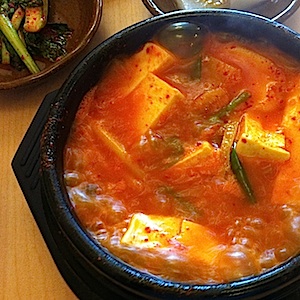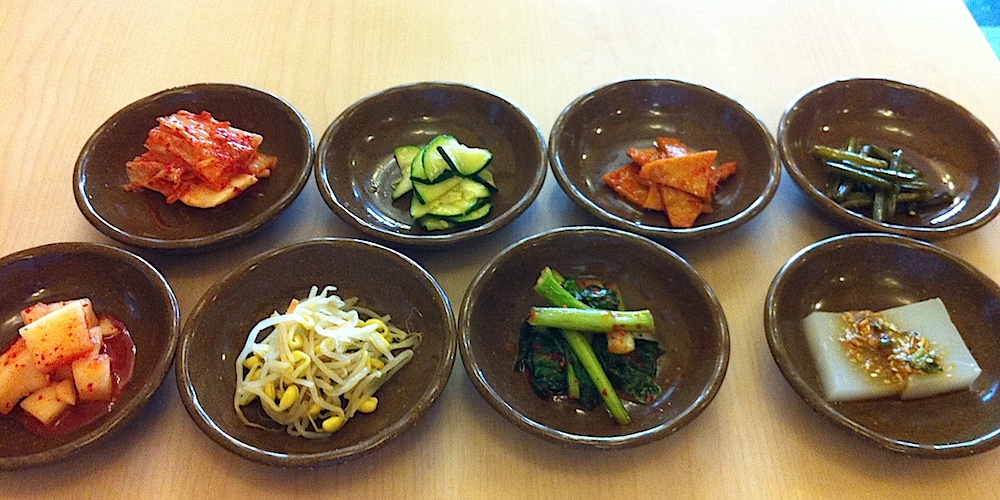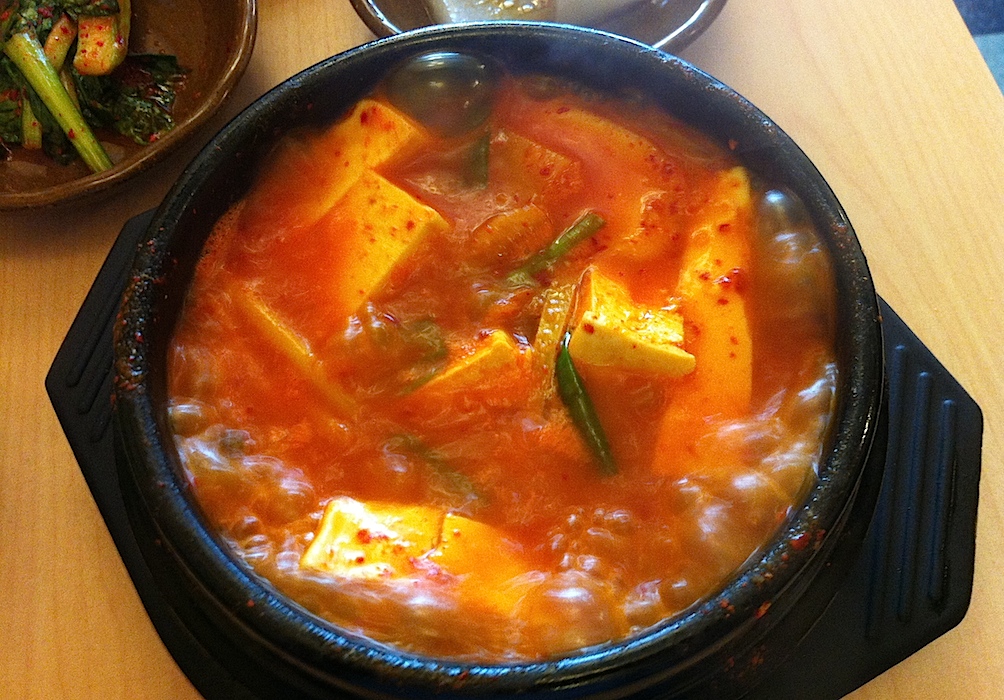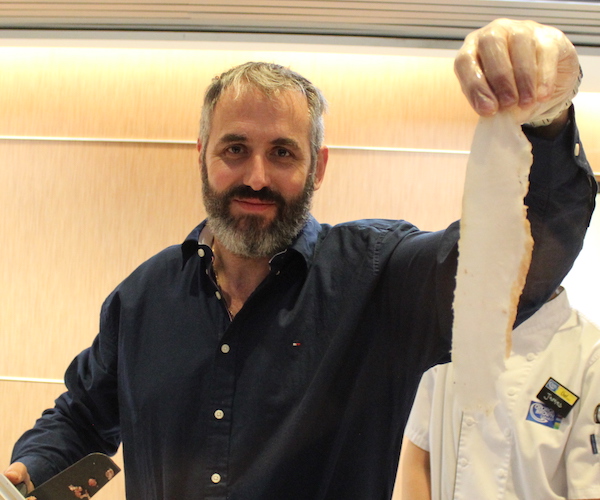From my, albeit limited, experience I have surmised that the dividing line between soup and stew in the cuisine of the Koreas is thin and quite possibly blurred. Or maybe the distinction is lost in the translation from Korean to laminated menu English. In either case, the ambiguity I perceive between the two dishes is only exarcerbated by my more or less complete ignorance of the peninsula’s gastronomic traditions. All subtlety is lost on me and the validity of my opinions can only to extend to what I like.
What I like a lot recently is the kimchi jjigae at Imonay Korean Restaurant at Bloor and Manning in Toronto’s (downtown) Koreatown. Jjigae must mean stew, if my menu reading is right, although it eats to me like what we’d call a soup in the West. My other great Korean lunch favourite Gamjatang is translated as “pork bone soup” and meets the standard Occidental definition by presenting itself as meat and vegetables swimming in broth. So does kimchi jjgae, at least with the addition of pork. (Thank goodness that kimchi has been adopted into our lexicon, or else the dish might have been rendered unorderable in English as “fermented cabbage stew”.) The main difference between Korean soups and stews, at least in Toronto, seems to be that the latter are served (literally) boiling hot in a cast iron crockpot. But I’ve had gamjatang served to me that way too, so I’m not sure. The solution to this dilemma is, of course, simply to call these dishes by their Korean names and enjoy them on their own delicious terms*.
The Kimchi jjigae service at Imonay begins with a generous array of banchan, the small plate appetizers-cum-sides that are served at all Korean restaurants. They serve as a measure of what’s to come. The breadth of what is offered at Imonay comes as a good portent, as does the general quality and care that has come with each little dish. The ultimate test, though, is the kimchi (especially if you’ve just ordered kimchi stew). Imonay’s ‘fresh’ kimchi is sublime: still crisp, full of sour zip, but also deep in umami flavour and chilli energy.
The restaurant is modestly appointed and clearly family owned. Guests are taken care of by an “auntie” for which it the restaurant is named. There’s no liquor licence, and at a recent lunch the customers were composed of young Korean-Canadian mothers with stroller-bound kids, suited Korean-Canadian businessmen and blue jeaned trades and students, and a sprinkling of not Korean hipsters. The menu is not long, and is (I think) focused on Korean comfort food. I get the sense that Imonay may be a Korean version of a good old country cooking family restaurant in small Ontario towns that are as famous for their pies as their rotisserie chicken, or whatnot. Anyway, it’s cozy and hospitable and a clumsy white guy who keeps taking pictures of his food and fumbles (still) with his chopsticks, dropping so many bean sprouts on the table, is made to feel absolutely welcome.
Hot and sour, that’s what the kimchi stew at Imonay delivers. But with such a rich underlying note of umami, not least from the fermented fish that went into the kimchi. It’s all about that broth. There are good things swimming in it: a good deal of tofu (ok, not my favourite, but in the jjigae’s liquid, I’ll take it and then some), a few rounds of that distinctly chewy fat Korean rice noodle, scallions, gnarly bits of pork (shoulder, I think)’ and of course Napa cabbage leaves. Oh, and chilli. There is some good chilli burn going down. I used my full white man’s plea for Korean spice levels. This technique also works, I have found, at other Asian and/or establishments staffed by former denizens of hot food cultures, when there is a bit of a language barrier. I stress that I want my dish spicy, and when I am asked a second time something to the effect of ‘are you sure you want it spicy?’, I grin, raise both my hands in a thumbs up and do my best crazed gameshow host impression below, ‘yes, please, very spicy!’ It’s not a dignified thing, for anyone involved, but it works insofar as it’s been a while since I got the white people’s bland version of what could have been a beautiful dish. And, the pleasure of the kimchi jjigae at Imonay is the synthesis of earthy broth, soaring kimchi sourness and chilli enhancement. The capsicum is the Dolby sound of it all, the effect of what my father’s amplifier accomplished by way of its ‘Loudness’ switch. High fidelity.
All this is yours for $9.
*My Anglo-Scots-Canadian antecedents 50 years ago were probably just as annoying about Italian food as I am sure I am about Korean. From what I understand, without the adoption of the word “pasta”, every formation of dough was deemed “spaghetti”.
 Malcolm Jolley is a founding editor of Good Food Revolution and Executive Director of Good Food Media, the company that publishes it. Follow him at twitter.com/malcolmjolley
Malcolm Jolley is a founding editor of Good Food Revolution and Executive Director of Good Food Media, the company that publishes it. Follow him at twitter.com/malcolmjolley











Trackbacks/Pingbacks